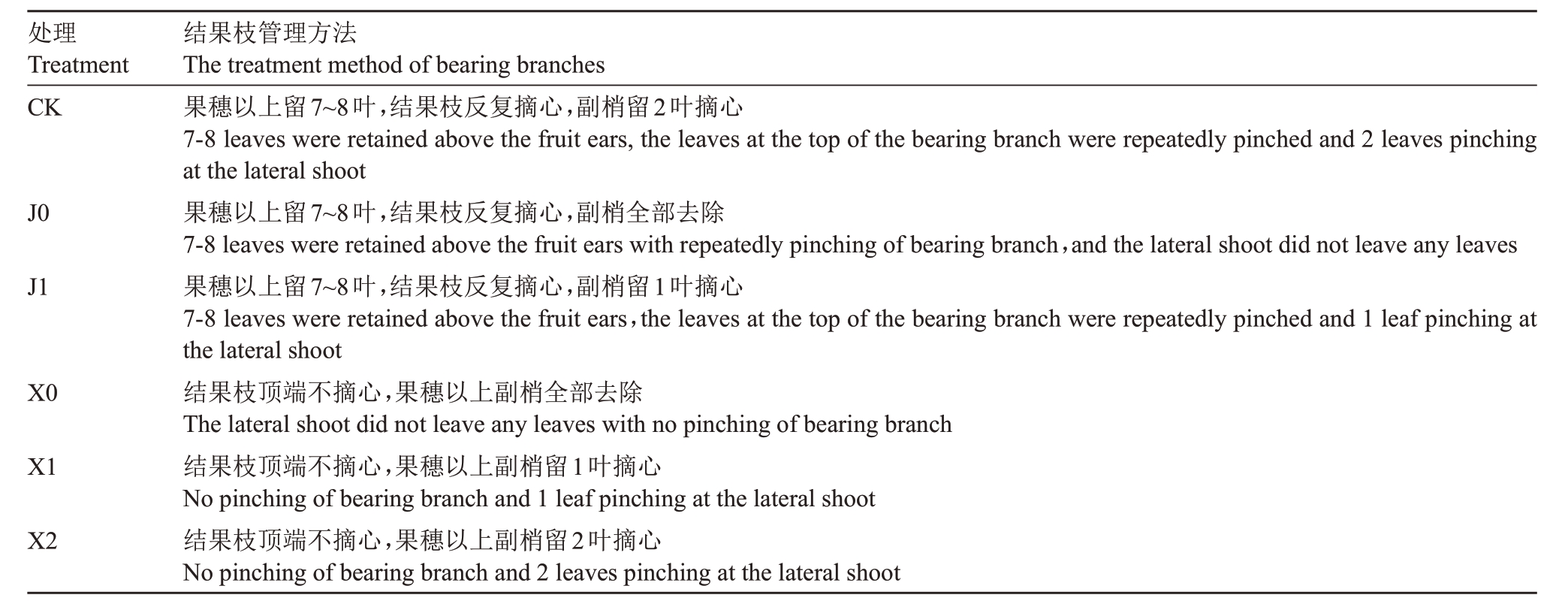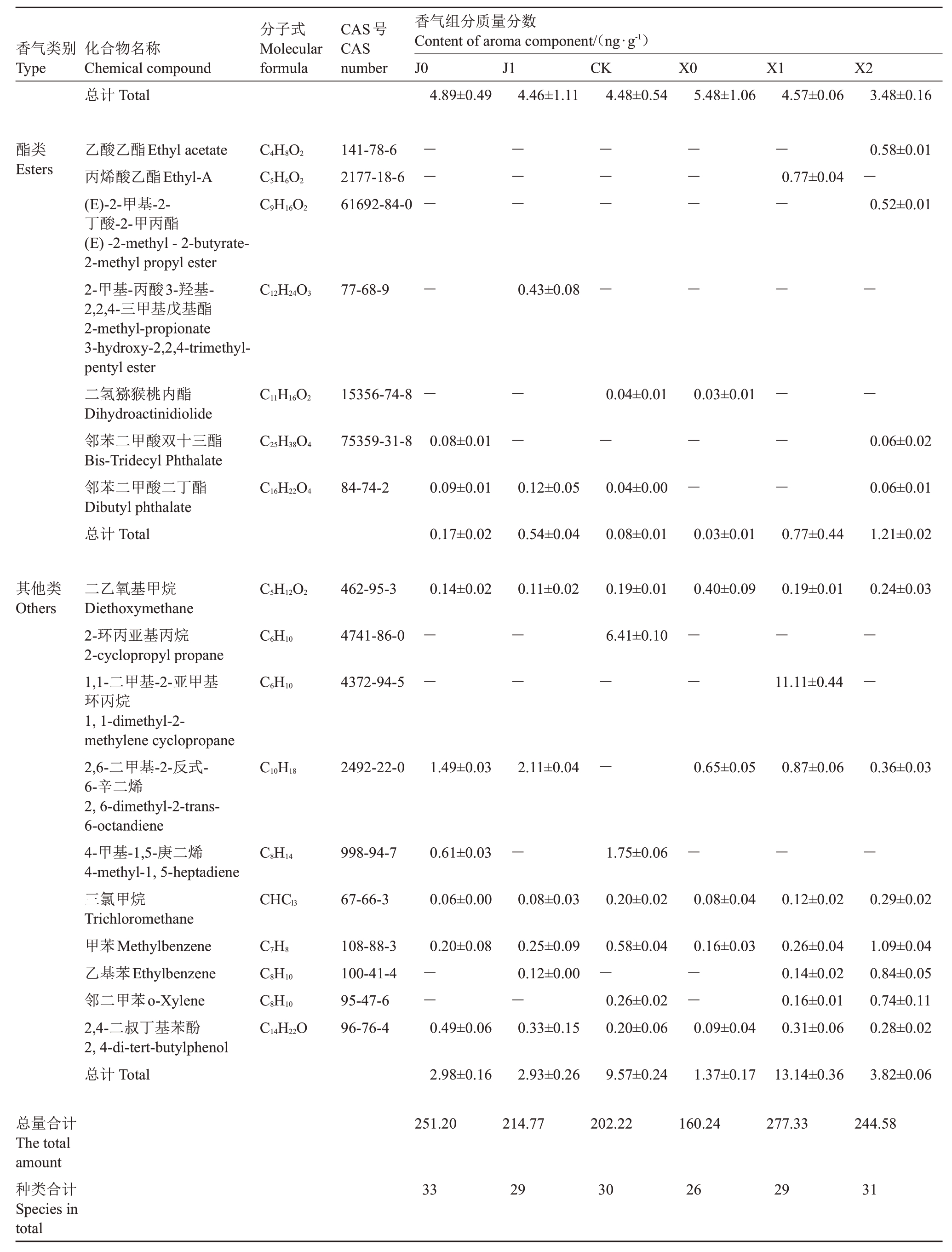葡萄生长季修剪是果园管理的重要技术措施,而夏季结果枝管理是夏季修剪的重要环节,可有效调节营养生长和生殖生长的平衡,改善通风透光条件,是提高果实品质的关键栽培措施。阳光玫瑰(Shine Muscat)葡萄属欧美杂交品种,2007年引入我国,经过十几年的发展,种植范围遍及全国各地[1]。但随着种植规模不断扩大,各地葡萄种植者管理水平参差不齐,葡萄枝梢和花果管理技术执行规范各异,果实品质差异较大。因此,研究阳光玫瑰葡萄的关键栽培管理技术对提高品质和风味,实行阳光玫瑰葡萄标准化栽培具有重要意义。
研究表明,结果枝管理方式影响葡萄的产量和品质。宋润刚等[2]对山葡萄3 个主栽品种进行了摘心试验,结果表明,3~5 片叶摘心有效提高了果穗质量、含糖量和出汁率,而且坐果率和产量也符合生产要求;董婕和代红军以不同副梢处理酿酒葡萄蛇龙珠,发现适当的副梢修剪有利于提高蛇龙珠葡萄的品质,副梢保留3 片叶处理能显著提高果穗长度、可溶性总糖和可溶性固形物含量[3]。付伟伟等[4]研究表明,“结果枝顶端保留1 副梢4 片叶+每节1 副梢留1 片叶/果穗上留1 副梢保留2 片叶”两种方法综合使用可明显提高巨峰葡萄坐果率;庞一波等[5]发现花前摘心和赤霉素处理可有效拉长寒香蜜、夏黑、瑞都香玉和新雅葡萄花序。
关于结果枝管理对葡萄品质影响的研究主要集中在酿酒葡萄上,在鲜食葡萄品种上的报道较少,阳光玫瑰葡萄的研究更少。针对目前阳光玫瑰葡萄结果枝留梢长度、副梢管理对品质的影响缺乏相应的研究,生产方面缺乏统一的标准,笔者在本研究中设置了结果枝不同管理组合,通过测定单果质量、可溶性固形物含量、可滴定酸含量、香气组分等指标,并对其进行综合评价;研究结果枝不同管理方式对阳光玫瑰葡萄果实品质的影响,为阳光玫瑰葡萄结果枝管理提供一定的技术参考。
1 材料和方法
1.1 试验材料
本试验在江苏省新沂市双塘镇夏冷云葡萄家庭农场进行。葡萄植株为4年生,南北行向种植,“一”字形整形,株行距1.5 m×3.0 m,平均干高1.2 m,采用双层塑料大棚避雨栽培。选取长势一致、生长健壮的葡萄植株作为试验材料。
1.2 田间试验设计
试验选取长势一致、生长健壮的葡萄植株,分6组设计,每组处理3株树,共计18株树,单株小区,3次重复。试验设计见表1 和图1。不同处理分别在盛花期、果实膨大期使用相同的植物生长调节剂处理。葡萄成熟前2 个月进行套袋,水肥管理相同。果实成熟后采收并测定品质指标。

图1 结果枝不同管理模式
Fig.1 The schematic drawing of different managements of bearing branches
表1 试验处理
Table 1 Experiment treatment

处理Treatment CK J0 J1 X0 X1 X2结果枝管理方法The treatment method of bearing branches果穗以上留7~8叶,结果枝反复摘心,副梢留2叶摘心7-8 leaves were retained above the fruit ears,the leaves at the top of the bearing branch were repeatedly pinched and 2 leaves pinching at the lateral shoot果穗以上留7~8叶,结果枝反复摘心,副梢全部去除7-8 leaves were retained above the fruit ears with repeatedly pinching of bearing branch,and the lateral shoot did not leave any leaves果穗以上留7~8叶,结果枝反复摘心,副梢留1叶摘心7-8 leaves were retained above the fruit ears,the leaves at the top of the bearing branch were repeatedly pinched and 1 leaf pinching at the lateral shoot结果枝顶端不摘心,果穗以上副梢全部去除The lateral shoot did not leave any leaves with no pinching of bearing branch结果枝顶端不摘心,果穗以上副梢留1叶摘心No pinching of bearing branch and 1 leaf pinching at the lateral shoot结果枝顶端不摘心,果穗以上副梢留2叶摘心No pinching of bearing branch and 2 leaves pinching at the lateral shoot
1.3 果实品质测定
果实成熟后在每株树的外围、中间、内膛各选取1 穗果实,每穗果实的上、中、下部随机共选取10 粒果实,每个处理总计90粒果实进行品质测定。使用电子天平测量单果质量,数显游标卡尺测量果实纵横径,果形指数以纵横径之比表示。将果肉用纱布挤汁,取上清液用RA-250手持式糖度仪测定可溶性固形物含量。使用酸碱中和滴定法测定可滴定酸含量。固酸比以可溶性固形物含量与可滴定酸含量之比表示。采用蒽酮比色法测定果实可溶性糖含量。
1.4 果实香气物质测定
果实香气物质的测定采用顶空固相微萃取(HS-SPME)法。将储存在-80 ℃冰箱内的果实样品取出,立即用液氮研磨成粉状,称取2 g 置于20 mL顶空瓶,加入1.5 g 氯化钠,以2µL 万分之一的3-辛醇(0.08 g·L-1)作为内标,用乙醇进行梯度稀释,完成后迅速盖紧盖子待用。取样前先在气相色谱仪进样口将固相萃取纤维头(50/30 μm DVB/CAR/PDMS,Supelco)老化,250 ℃老化30 min。将制备好的样品瓶放入Thermo RSH 自动进样器中等待萃取,萃取过程由进样器的SPME模块自动完成,程序为:设定炉温箱50 ℃,样品先平衡25 min,固相微萃取纤维头250 ℃老化3 min后,在样品瓶上空吸附20 min,插入进样口(250 ℃)解析5 min,启动仪器采集数据,进行定性定量分析。
1.5 数据处理
采用Excel 2019 制作基本图表,SPSS 22.0 进行数据显著性分析,Origin 2021 完成相关性分析和聚类分析,以0.05水平作为显著性相关的阈值。
2 结果与分析
2.1 结果枝不同管理方式对阳光玫瑰葡萄果实单果质量、纵横径、果形指数的影响
根据图2 可知,结果枝不同处理方式对葡萄单果质量与对照(CK)相比均无显著差异,J0组处理和J1组处理的单果质量略高于CK组,分别为9.84 g和9.95 g。但与X2组相比,J0组和J1组处理的单果质量显著提高。结果枝果穗以上留7~8叶摘心处理与不摘心长放相比,摘心有利于提高单果质量,如处理J1、J2 和CK 的单果质量普遍大于X0、X1 和X2;结果枝不留副梢与副梢留1叶或2叶摘心相比,留1叶摘心有利于提高单果质量,如J1的单果质量大于J0和CK,X1的单果质量大于X0和X2,但差异不显著(图2-B)。

图2 不同结果枝处理方式对果实形态(A)、单果质量(B)、纵横径(C)和果形指数(D)的影响
Fig.2 Effects of different bearing branches management on fruit morphology(A),berry weight(B),vertical and transverse diameters(C)and index of fruit shape(D)
不同小写字母表示在p<0.05 差异显著。下同。
Different small letters indicate significant difference at p<0.05.The same below.
从图2-C 可以看出,J0 组、J1 组、X0 组、X1 组处理的果实纵径与CK 组相比均无显著区别,X2 组(31.88 mm)处理的果实纵径显著低于CK 组(33.92 mm)、J0 组(33.74 mm)和X1 组(33.66 mm)。J1组处理的横径显著高于CK组,横径达到26.72 mm,比对照提高了1.42 mm,其余处理的果实横径与对照组相比均无明显差异。X2 组处理的果实横径显著低于J0和J1组。在相同的副梢管理时,与结果枝长放相比,结果枝摘心均能够增加果实的横径;结果枝无论长放还是摘心处理,副梢留2 片叶摘心的果实横径均最小。
从图2-A、2-D可以看出,J0、J1组处理的果形指数均显著低于CK组,X0、X1、X2处理的果形指数与CK 组相比无明显差异,其中,J1 组处理的果形指数显著低于J0 组,说明J1 组处理的果实更接近圆形,而对照处理的果实更接近长椭圆形。
综上所述,J1 组处理(果穗以上留7~8 叶,结果枝反复摘心、副梢留1片叶摘心)能够显著提高果实的横径,其他处理与生产中常规管理方式(CK)相比,阳光玫瑰葡萄的单果质量、纵径和果形指数没有显著提高。
2.2 对果实可溶性固形物含量、可滴定酸含量和固酸比的影响
如图3,J1组(果穗以上留7~8叶,结果枝反复摘心,副梢留1叶)处理的可溶性固形物含量和固酸比显著高于X0、X1组处理,为6组中最高。J0、J1和X0组处理的可溶性糖含量均显著高于CK 组,分别为14.35%、14.40%和10.87%,比对照分别提高了5.41%、5.46%和1.93%。结果枝无论长放还是摘心处理,副梢不留叶处理的可溶性糖含量高于副梢留2片叶处理,副梢留2片叶处理的果实可溶性糖含量最低。

图3 结果枝不同管理方式对阳光玫瑰葡萄内在品质的影响
Fig.3 Effects of different bearing branches management on internal quality of Shine Muscat grape
2.3 对阳光玫瑰葡萄果实香气物质的影响
2.3.1 阳光玫瑰葡萄香气物质含量与种类比较 如图4和表2所示,阳光玫瑰葡萄各处理的香气成分以醛、醇两类物质含量最高,是主要香气成分。醛类物质中以正己醛和2-己烯醛含量最高,醇类物质中以正己醇含量最高,酮、酯、萜烯类物质含量均较少。J0 组处理的醛类物质种类最多,共9 种。2-己烯醛和正己醛是含量最高的两种醛类物质。X0 组处理的酮类物质总含量最高,各组检测出的酮类物质种类均为2~3种。J0、J1、X1、X2处理的酯类物质总含量均显著高于CK组和X0组,总含量从高到低排序为X2>X1>J1>J0>CK、X0。各组处理的萜烯类物质含量均较少,检测出的其他类物质相对含量均不高。

图4 不同结果枝处理对香气物质种类及含量的影响
Fig.4 Effects of different bearing branches management on the types and contents of aroma substances
表2 不同枝叶处理对阳光玫瑰葡萄香气成分种类及含量的影响
Table 2 Effects of different branches and leaves treatment on the types and contents of aroma components of Shine Muscat grape

香气类别Type化合物名称Chemical compound分子式Molecular formula CAS号CAS number香气组分质量分数Content of aroma component/(ng·g-1)J0 J1 CK X0 X1 X2萜烯类Terpenes芳樟醇Linalool(+)-α-松油醇(+)-α-terpineol α-松油醇α-terpineol香叶醇Geraniol总计Total C10H18O C10H18O 78-70-6 7785-53-7 2.47±0.63 0.97±0.06 0.85±0.07 0.27±0.05 0.38±0.09 0.15±0.09 0.72±0.01 0.21±0.02 1.00±0.04 0.28±0.04 2.10±0.01 0.54±0.00 C10H18O C10H18O 98-55-5 106-24-1 0.50±0.07 0.23±0.08 4.17±0.84 0.23±0.01 0.24±0.08 1.58±0.21 0.18±0.09—0.71±0.08—————0.93±0.01 1.27±0.01 0.40±0.00 3.04±0.01醇类Alcohols 2-己炔-1-醇2-hexyne-1-alcohol顺-3-己烯-1-醇Cis-3-hexene-1-ol 3-己烯-1-醇3-hexene-1-ol反式-3-己烯-1-醇Trans-3-hexene-1-ol反式-2-己烯醇Trans-2-hexenol正己醇hexyl alcohol 1-辛烯-3-醇1-octene-3-ol 2-乙基己醇2-ethyl hexanol(2Z)-2-辛烯-1-醇(2Z)-2-octene-1-ol正辛醇N-caprylic alcohol总计Total C6H10O C6H12O C6H12O C6H12O C6H12O C6H14O C8H16O C8H18O C8H16O C8H18O 764-60-3 1.20±0.37 928-96-1 16.07±1.40 544-12-7 9.55±0.55 544-12-7—928-95-0 7.20±2.87 111-27-3 3391-86-4 14.07±4.83 1.59±0.35 104-76-7 2.01±0.25 26001-58-1 0.27±0.03 111-87-5 0.17±0.03 52.12±7.81 1.14±0.19——11.06±1.38 5.55±1.2 11.18±1.72 2.16±0.65——31.09±5.14 0.83±0.23 11.46±1.11——6.55±2.16 13.67±4.70 2.31±0.14—0.50±0.01—35.31±6.13 0.78±0.11——5.09±0.83 11.82±3.24 1.81±0.16—0.26±0.01 0.24±0.09 22.85±3.89 1.18±0.09——14.31±0.34 5.47±0.59 20.87±4.56 2.40±0.15 1.46±0.04 0.26±0.05—45.93±5.42 1.14±0.19 11.41±0.09——6.10±0.06 21.70±1.48 1.31±0.02 1.06±0.09 0.19±0.00—42.86±1.15醛类Aldehydes乙醛Acetaldehyde丙酮醛Methylglyoxal戊醛Valeraldehyde正己醛N-hexana 2-己烯醛2-hexene aldehyde 2-庚烯醛2-heptene Aldehyde苯乙醛Phenylacetaldehyde壬醛Pelargonaldehyde正癸醛N-decyl aldehyde总计Total C2H4O C3H4O2 C5H10O C6H12O C6H10O C7H12O C8H8O C9H18O C10H20O 75-07-0 78-98-8 110-62-3 66-25-1 505-57-7 0.79±0.27 5.74±0.19 0.50±0.21 56.48±10.14 116.90±36.24 0.75±0.04 3.52±0.72 0.36±0.11 50.69±7.88 114.98±19.72 0.71±0.12 5.61±1.85 0.33±0.06 50.56±16.19 91.83±28.28—2.05±0.57 4.32±0.09 0.35±0.07 32.28±7.72 89.86±21.38——0.29±0.03 76.71±5.47 130.94±10.80——65.65±4.85 118.74±9.83 57266-86-1 1.32±0.54 1.81±0.54 2.05±0.09 0.74±0.03 1.30±0.45 0.46±0.02 122-78-1 0.71±0.21 1.54±0.11 0.44±0.11 0.32±0.14 0.89±0.17 1.08±0.28 124-19-6 112-31-2 2.19±1.22 2.25±0.17 186.87±46.41 0.54±0.11—174.17±29.21 0.55±0.16—152.07±46.86 1.47±0.69 0.73±0.36 129.58±29.90 1.31±0.01 0.23±0.05 211.65±15.57 1.75±0.01 0.44±0.01 190.17±13.91酮类Ketones 1-辛烯-3-酮1-octene-3-ketone甲基庚烯酮6-Methyl-5-hepten-2-one香叶基丙酮Geranyl acetone C8H14O 4312-99-6 0.67±0.06 0.47±0.15 0.68±0.12—0.54±0.15—C8H14O 110-93-0 3.62±0.38 3.40±0.77 3.12±0.54 4.76±0.71 3.54±0.13 3.04±0.15 C13H22O 3796-70-1 0.61±0.06 0.60±0.20 0.69±0.12 0.73±0.36 0.49±0.04 0.44±0.01
表2 (续)Table 2(Continued)

注:—. 未检出。
Note:—.Not detected.
香气类别Type化合物名称Chemical compound分子式Molecular formula CAS号CAS number香气组分质量分数Content of aroma component/(ng·g-1)J0 J1 CK X0 X1 X2总计Total 4.89±0.49 4.46±1.11 4.48±0.54 5.48±1.06 4.57±0.06 3.48±0.16酯类Esters乙酸乙酯Ethyl acetate丙烯酸乙酯Ethyl-A(E)-2-甲基-2-丁酸-2-甲丙酯(E)-2-methyl-2-butyrate-2-methyl propyl ester 2-甲基-丙酸3-羟基-2,2,4-三甲基戊基酯2-methyl-propionate 3-hydroxy-2,2,4-trimethylpentyl ester二氢猕猴桃内酯Dihydroactinidiolide邻苯二甲酸双十三酯Bis-Tridecyl Phthalate邻苯二甲酸二丁酯Dibutyl phthalate总计Total C4H8O2 C5H6O2 C9H16O2 C12H24O3 C11H16O2 C25H38O4 C16H22O4 141-78-6 2177-18-6 61692-84-0 77-68-9 15356-74-8— — — —75359-31-8 0.08±0.01 84-74-2 0.09±0.01 0.17±0.02— —0.43±0.08——0.12±0.05 0.54±0.04— — —0.04±0.01—0.04±0.00 0.08±0.01— — —0.03±0.01——0.03±0.01—0.77±0.04————0.77±0.44 0.58±0.01—0.52±0.01——0.06±0.02 0.06±0.01 1.21±0.02其他类Others二乙氧基甲烷Diethoxymethane 2-环丙亚基丙烷2-cyclopropyl propane 1,1-二甲基-2-亚甲基环丙烷1,1-dimethyl-2-methylene cyclopropane 2,6-二甲基-2-反式-6-辛二烯2,6-dimethyl-2-trans-6-octandiene 4-甲基-1,5-庚二烯4-methyl-1,5-heptadiene三氯甲烷Trichloromethane甲苯Methylbenzene乙基苯Ethylbenzene邻二甲苯o-Xylene 2,4-二叔丁基苯酚2,4-di-tert-butylphenol总计Total C5H12O2 C6H10 C6H10 C10H18 C8H14 CHCl3 C7H8 C8H10 C8H10 C14H22O 462-95-3 4741-86-0 4372-94-5 2492-22-0 998-94-7 67-66-3 108-88-3 100-41-4 95-47-6 96-76-4 0.14±0.02——1.49±0.03 0.61±0.03 0.06±0.00 0.20±0.08——0.49±0.06 2.98±0.16 0.11±0.02——2.11±0.04—0.08±0.03 0.25±0.09 0.12±0.00—0.33±0.15 2.93±0.26 0.19±0.01 6.41±0.10——1.75±0.06 0.20±0.02 0.58±0.04—0.26±0.02 0.20±0.06 9.57±0.24 0.40±0.09——0.65±0.05—0.08±0.04 0.16±0.03——0.09±0.04 1.37±0.17 0.19±0.01—11.11±0.44 0.87±0.06—0.12±0.02 0.26±0.04 0.14±0.02 0.16±0.01 0.31±0.06 13.14±0.36 0.24±0.03——0.36±0.03—0.29±0.02 1.09±0.04 0.84±0.05 0.74±0.11 0.28±0.02 3.82±0.06总量合计The total amount种类合计Species in total 251.20 214.77 202.22 160.24 277.33 244.58 33 29 30 26 29 31
2.3.2 香气成分聚类分析 以6种不同结果枝处理方式成熟的阳光玫瑰葡萄果实的香气种类和含量数据为基础,通过聚类热图来进一步解析结果枝不同处理方式阳光玫瑰果实的香气特征。由图5可知,6种处理方式可分为2 簇,一簇是J0、J1、X1 和X2;一簇是CK 和X0。相较于其他处理,J0 处理方式的醇类物质和萜烯类物质含量均高于其他处理,其中萜烯类物质芳樟醇、(+)-α-松油醇、反式-2-己烯醇含量都较其他处理高;其次是X1 组处理,醛类物质含量高于其他处理,包括己醛、2-己烯醛含量等,高含量的醛类香气使得该处理葡萄果实具有轻微的青草香;第三为X2组处理,酯类、正己醇等物质含量高于其他处理;第四为J1 和CK 处理,醇类、醛类物质含量低于除X0外的其他处理;第五为X0处理,物质总量和种类均为各组最低。综上,各结果枝处理对香气物质影响排序为J0>X1>X2>J1、CK>X0,同时也印证了CK 和X0 处理区别于其他处理的聚类分析结果,J0组处理在香气物质种类和总含量上均体现出优势。

图5 不同结果枝处理的果实香气物质聚类分析
Fig.5 Cluster analysis of fruit aroma substances under different bearing branches managements
3 讨 论
结果枝管理方式是夏季修剪的重要技术措施,通过摘心调整叶幕结构、改善微气候,能有效提高浆果可溶性固形物含量和果皮色素含量[6]。本试验研究表明,果穗以上留7~8 叶、结果枝反复摘心、副梢留1 片叶摘心处理能够提高果实横径、可溶性固形物含量以及固酸比,并显著提高可溶性糖含量,与前人在巨峰葡萄上的研究结果一致[4,7]。结果枝摘心处理的果实单果质量均大于结果枝长放处理,这与杜社妮等[8]、李明霞等[9]的研究结果一致。结果枝摘心处理的果实横径和固酸比均大于结果枝长放处理,推测结果枝摘心有利于叶片光合作用产物集中供应果实生长发育,而结果枝长放,存在营养生长与果实生长发育两个生长中心,竞争养分削弱了果实生长。结果枝无论摘心还是长放处理,副梢留2 片叶处理的果实单果质量、横径、可溶性糖含量均最低,副梢留1 片叶处理的单果质量均最大,这与郑晓翠等[10]在巨峰葡萄上的研究结果一致,与刘万好等[11]在赤霞珠葡萄的研究存在差异,这可能是受品种和气候差异的影响。
葡萄果实中香气物质主要有醇类、醛类、酯类、酮类和萜烯类等,果实中的特征香气决定了香气类型,特征香气取决于香气浓度及感知阈值[12-14]。玫瑰香型葡萄果实香气中含有丰富的单萜类物质,主要有芳樟醇、香叶醇、橙花醇、萜品醇和香茅醇,其具有浓郁的花香和果香,感知阈值低,而对玫瑰香气贡献最大的是感知阈值最低的芳樟醇[15-18]。醛类、醇类、酮类是葡萄草香味的主要贡献者,被称作绿叶挥发物(GLVs),C6 酯类对葡萄草莓香味具有重要贡献[19-21]。
果实香气是鲜食葡萄品质的重要感官指标,香气化合物的成分、含量受品种、生态环境、栽培模式、果实成熟度和处理手段等多种因素影响[22-24]。葡萄香气成分含量在各发育时期有所不同。萜类化合物在果实软化期浓度最低,在果实转色后期开始大量合成,在果实成熟早期达到最高峰,而在后熟时期因为挥发会有所下降。张克坤等[7]研究表明,葡萄延迟采收后萜烯类主要物质为芳樟醇,呈现先稳定再急剧下降趋势。C6化合物在果实转色后大量积累,在成熟早期C6醇和酯类化合物含量上升,至完全成熟时浓度达到最大,而在成熟后期会有所下降[25]。在本试验中,J0 处理方式(果穗以上留7~8 叶、结果枝反复摘心、副梢不留叶)的醇类物质和萜烯类物质含量均高于其他处理,尤其是芳樟醇和(+)-α-松油醇等单萜类物质,除X2组处理(结果枝顶端不摘心,果穗以上副梢留2叶摘心)外,其他处理方式果实的萜烯类物质含量均显著低于J0组处理,说明果穗以上留7~8叶、结果枝反复摘心、副梢不留叶对增加阳光玫瑰葡萄玫瑰香气具有一定作用。X1处理组(结果枝顶端不摘心,果穗以上副梢留1 叶摘心)的醛类、酮类物质含量高于其他处理,但不显著,使得该处理葡萄果实具有轻微的青草香。但是所有处理组果实的醇、醛类香气物质相对含量最高,萜烯类和酯类物质相对含量低,尤其是赋予阳光玫瑰葡萄浓郁玫瑰香味的芳樟醇含量很低,该现象可能与本试验中采收时期和果实套绿袋有关,影响了萜烯物质的合成与积累。
4 结 论
采用果穗以上留7~8 叶,结果枝反复摘心、副梢不留叶进行夏季结果枝修剪,能够显著改善阳光玫瑰葡萄果实品质,可为果农带来更高的经济效益。
[1] 杨治元,陈哲.阳光玫瑰葡萄规模种植情况调查初报[J].中外葡萄与葡萄酒,2017(1):59-60.YANG Zhiyuan,CHEN Zhe. Preliminary report on the survey of Shine Muscat grape growing on a large scale[J]. Sino-Overseas Grapevine&Wine,2017(1):59-60.
[2] 宋润刚,张国华,路文鹏,沈育杰,李昌禹,杨义明,李晓红,张宝香.不同留叶数摘心对山葡萄主栽品种果实品质和产量的影响[J].中外葡萄与葡萄酒,2006(6):15-17.SONG Rungang,ZHANG Guohua,LU Wenpeng,SHEN Yujie,LI Changyu,YANG Yiming,LI Xiaohong,ZHANG Baoxiang.Effect of different leaves pinching of bearing branches on fruit quality and yield in mainplanted varieties of Vitis amurensis Rupr.[J].Sino-Overseas Grapevine&Wine,2006(6):15-17.
[3] 董婕,代红军.不同副梢处理对酿酒葡萄生长及果实品质的影响[J].农业科学研究,2015,36(2):13-16.DONG Jie,DAI Hongjun. Effect on different axillary shoot treatments in grape growth and berry quality of‘Cabernet Gernischt’grape[J]. Journal of Agricultural Sciences,2015,36(2):13-16.
[4] 付伟伟,郭修武,亚莉.新梢摘心和副梢处理方法对巨峰葡萄果实品质的影响[J].陕西农业科学,2008,54(2):32-36.FU Weiwei,GUO Xiuwu,YA Li. Effect of different shoot pinching and secondary shoot treatment on the Kyoho Grape quality[J]. Shaanxi Journal of Agricultural Sciences,2008,54(2):32-36.
[5] 庞一波,刘也楠,吴江,陈剑,朱潇婷.花前摘心和赤霉素处理对葡萄花序拉长的影响[J].江苏农业科学,2020,48(23):129-133.PANG Yibo,LIU Yenan,WU Jiang,CHEN Jian,ZHU Xiaoting.Effects of pre-flower pinching and gibberellin treatment on inflorescence elongation of several grape cultivars[J].Jiangsu Agricultural Sciences,2020,48(23):129-133.
[6] KLIEWER W M,DOKOOZLIAN N K. Leaf area/crop weight ratios of grapevines:Influence on fruit composition and wine quality[J].American Journal of Enology and Viticulture,2005,56(2):170-181.
[7] 张克坤,王海波,王孝娣,史祥宾,王宝亮,郑晓翠,刘凤之.‘意大利’葡萄延迟栽培挂树贮藏期间果实品质的变化[J].园艺学报,2016,43(5):853-866.ZHANG Kekun,WANG Haibo,WANG Xiaodi,SHI Xiangbin,WANG Baoliang,ZHENG Xiaocui,LIU Fengzhi. Studies on quality development of‘Italia’grape during on-vine storage under delayed cultivation[J].Acta Horticulturae Sinica,2016,43(5):853-866.
[8] 杜社妮,白岗栓,李明霞,耿桂俊.更新修剪对衰老‘富士’苹果枝条生长及树冠结构的影响[J].中国农业大学学报,2012,17(3):74-80.DU Sheni,BAI Gangshuan,LI Mingxia,GENG Guijun.Effects of renewal pruning on shoot development and crown structure of the aging Fuji apple tree[J]. Journal of China Agricultural University,2012,17(3):74-80.
[9] 李明霞,耿桂俊,白岗栓,杜社妮,李晶晶.更新修剪对盛果末期苹果光合能力及果实品质的影响[J].西北农林科技大学学报(自然科学版),2011,39(1):179-185.LI Mingxia,GENG Guijun,BAI Gangshuan,DU Sheni,LI Jingjing.Effect of renewal pruning on apple photosynthetic ability and fruit quality in final full productive stage[J]. Journal of Northwest A&F University(Natural Science Edition),2011,39(1):179-185.
[10] 郑晓翠,刘凤之,王志强,王孝娣,王宝亮,史祥宾,王海波.副梢简化修剪对‘巨峰’葡萄果实品质与香气成分的影响[J].中国果树,2017(3):41-44.ZHENG Xiaocui,LIU Fengzhi,WANG Zhiqiang,WANG Xiaodi,WANG Baoliang,SHI Xiangbin,WANG Haibo. Effect of simplified pruning of secondary tips on fruit quality and aroma composition of‘Giant Peak’grapes[J]. China Fruits,2017(3):41-44.
[11] 刘万好,唐美玲,王恒振,郑秋玲,张超杰,王婷,刘珅坤,肖慧琳,管雪强,王世平.副梢处理方式对赤霞珠葡萄光合作用及果实品质的影响[J].山东农业科学,2016,48(9):60-64.LIU Wanhao,TANG Meiling,WANG Hengzhen,ZHENG Qiuling,ZHANG Chaojie,WANG Ting,LIU Shenkun,XIAO Huilin,GUAN Xueqiang,WANG Shiping. Effects of lateral shoot treatment on photosynthesis and fruit quality of Cabernet Sauvignon grape[J]. Shandong Agricultural Sciences,2016,48(9):60-64.
[12] TOMAS BARBERAN F A.Phytochemistry of fruit and vegetables[M].Oxford:Oxford University Press,1997:23-25.
[13] SONG J,FORNEY C F.Flavour volatile production and regulation in fruit[J].Canadian Journal of Plant Science,2008,88(3):537-550.
[14] SEYMOUR G B,TAYLOR J E,TUCKER G A. Biochemistry of fruit ripening[M].Springer Science&Business Medi,2012.
[15] MARAIS J. Terpenes in the aroma of grapes and wines:a review[J]. South African Journal of Enology and Viticulture,1983,4(2):49-58.
[16] DUDAREVA N,NEGRE F,NAGEGOWDA D A,ORLOVA I.Plant volatiles:Recent advances and future perspectives[J].Critical Reviews in Plant Sciences,2006,25(5):417-440.
[17] FENOLL J,MANSO A,HELLIN P,RUIZ L,FLORES P.Changes in the aromatic composition of the Vitis vinifera grape Muscat Hamburg during ripening[J]. Food Chemistry,2009,114(2):420-428.
[18] GENOVESE A,LAMORTE S A,GAMBUTI A,MOIO L.Aroma of Aglianico and Uva di Troia grapes by aromatic series[J].Food Research International,2013,53(1):15-23.
[19] KALUA C M,BOSS P K.Evolution of volatile compounds during the development of Cabernet Sauvignon grapes (Vitis vinifera L.)[J]. Journal of Agricultural and Food Chemistry,2009,57(9):3818-3830.
[20] YANG C,WANG Y,LIANG Z,FAN P,WU B,YANG L,WANG Y,LI S.Volatiles of grape berries evaluated at the germplasm level by headspace-SPME with GC-MS[J].Food Chemistry,2009,114(3):1106-1114.
[21] 刘孟龙,于梦,王文霞,杜远鹏.山东蓬莱、平度及东营‘玫瑰香’葡萄香气比较[J].中国果树,2021(2):13-19.LIU Menglong,YU Meng,WANG Wenxia,DU Yuanpeng.The aroma difference of‘Muscat’grape in Penglai,Pingdu and Dongying of Shandong Province[J].China Fruits,2021(2):13-19.
[22] CHAPMAN D M,MATTHEWS M A,GUINARD J X. Sensory attributes of cabernet sauvignon wines made from vines with different crop yields[J].American Journal of Enology and Viticulture,2004,55(4):325-334.
[23] 张明霞,吴玉文,段长青.葡萄与葡萄酒香气物质研究进展[J].中国农业科学,2008,41(7):2098-2104.ZHANG Mingxia,WU Yuwen,DUAN Changqing. Progress in study of aromatic compounds in grape and wine[J].Scientia Agricultura Sinica,2008,41(7):2098-2104.
[24] 李慧峰,王海波,李林光,吕德国,杨建明.套袋对‘寒富’苹果果实香气成分的影响[J]. 中国生态农业学报,2011,19(4):843-847.LI Huifeng,WANG Haibo,LI Linguang,LÜ Deguo,YANG Jianming. Effects of bagging on‘Hanfu’apple aroma compounds[J]. Chinese Journal of Eco-Agriculture,2011,19(4):843-847.
[25] WU Y,ZHANG W,SONG S,XU W,ZHANG C,MA C,WANG L,WANG S. Evolution of volatile compounds during the development of Muscat grape‘Shine Muscat’(Vitis labrusca×V.vinifera)[J].Food Chemistry,2020,309:125778.https://doi.org/10.1016/j.foodchem.2019.125778